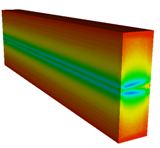Speaker
Nick SIMOS
(BNL)
Description
Demand for high-performance materials that can safely intercept the LHC proton beam has prompted an
extensive experimental study focusing on material degradation due to long radiation exposure. Given the
multi-MW class of the beam interception process at LHC combined with the stringent positional requirements
on the intercepting elements, the envelope of the current knowledge regarding material behavior and endurance
for both short and long exposure needs to be extended. For the collimating structures intercepting the halo of
an intense beam under normal or the entire beam during off-normal conditions, performance issues are essential
and directly tied to materials and their ability to maintain key properties and absorb beam-induced shock.
The limitations of most materials in playing such pivotal roles have led to an extensive search and experimentation
with new alloys and composites that appear to possess the right combination of properties.
Post-irradiation analysis results following exposure to the 200 MeV protons at the end of the BNL Linac will be
presented. In addition, preliminary results of estimated neutron-induced damage on LHC materials will be
discussed as a result of experimentation with a “unique” neutron source at BNL.
Co-authors: MOKHOV Nikolai (BNL)
Authors
Nick SIMOS
(BNL)
Nikolai MOKHOV
(FERMILAB)
